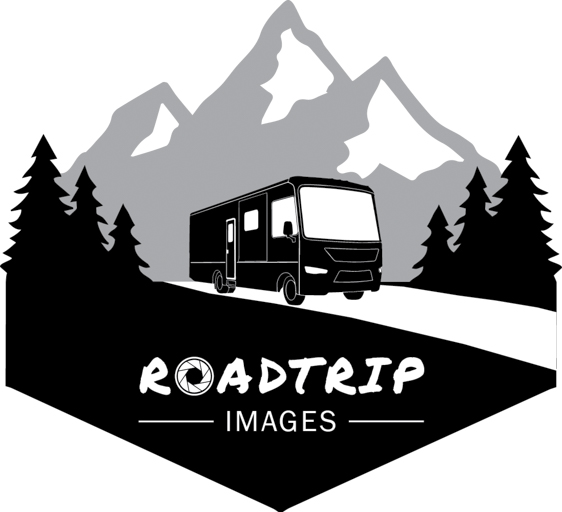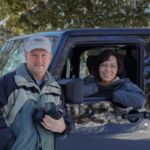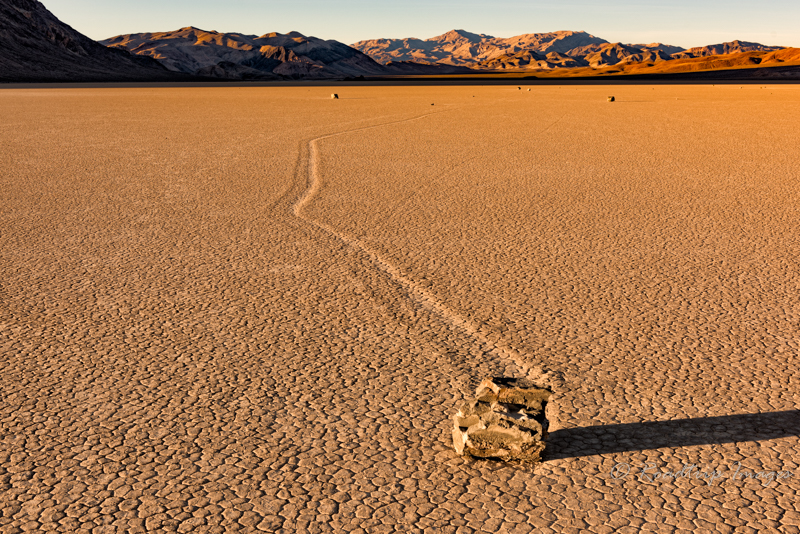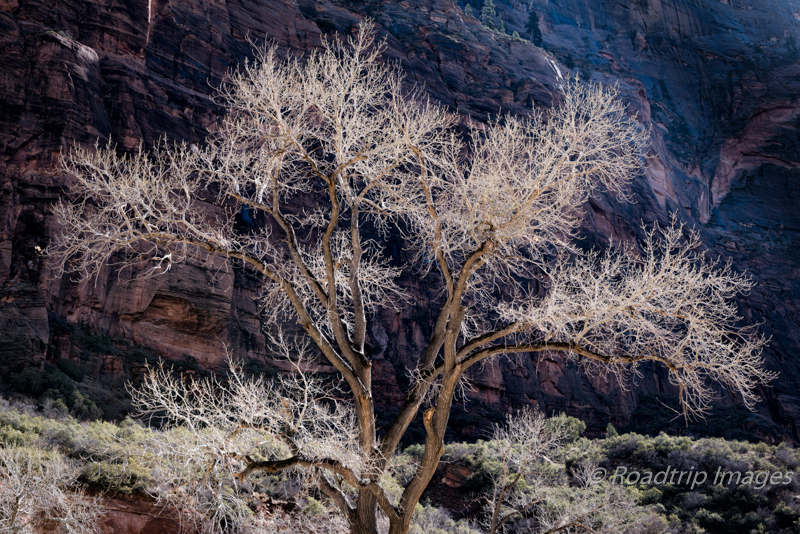The Towers of the Virgin - Clearing Storm
The Towers of the Virgin in Zion National Park are an impressive view. Even more so when there’s a clearing winter storm.
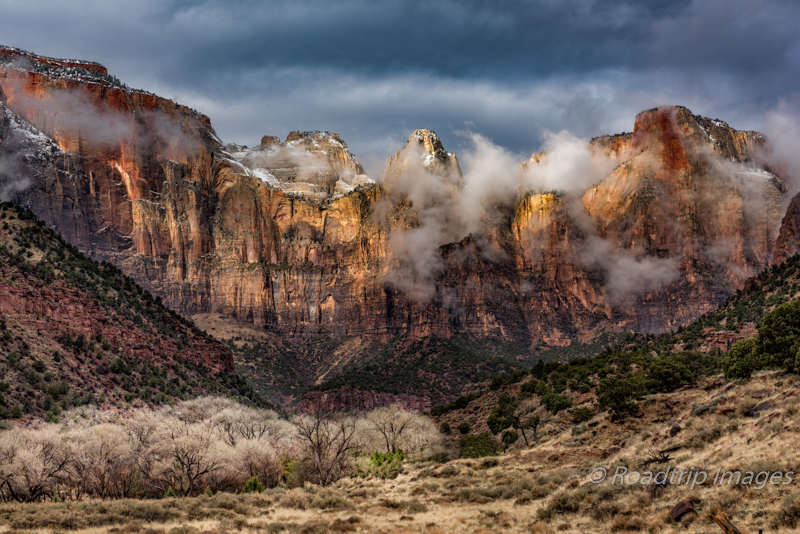
Zion NP in winter
So as we were getting ready to leave Death Valley, we didn’t really have a plan where to go next. We’re heavily influenced by the weather and looking around the region we noticed that one of our favorite National Parks, Zion, was having a mild stretch of weather. We hadn’t been to Zion in the winter before so we said, “why not”? It took a few days of driving to get from Death Valley to Zion but we needed to start moving east anyway. In the winter the campsites are first come first served. No reservations. We were able to get a campsite in the Watchman campground even though the large loop for RV’s (loop B) was closed for construction. We ended up with a nice pull through with 50A power. One of the few 50A sites in loop A. Score!
Zion in winter is different. The heavy crowds are gone. The trees are bare. The mandatory shuttle buses are idle. You’re free to drive the main Zion Canyon drive and park at the various stops. This allows a lot more flexibility. We can now go from spot to spot much quicker as we’re searching for the light. During the warmer months, the park runs a shuttle bus system on the main canyon drive and doesn’t allow private vehicles. This manages the congestion that would otherwise be there with so many cars on this one road. I had a couple of shots in mind that I wanted to get on this trip so we set out in search of compositions.
Our first day or so in the park were met with sunny days and pretty warm temps for winter. We focused our search on the bare cottonwood trees as they had a wonderful glow when backlit by the sun. We found several possible compositions and made some notes on when to come back when the light was just right. I really wanted to get a shot of the silvery tips of the cottonwoods against the richly colored sandstone walls of Zion Canyon. Shortly after we arrived the weather forecast turned. Precipitation was moving in as well as colder temps. Normally this would be bad news for campers. You generally want warm sunny days when you’re camping. As a photographer I want changing weather. Weather in transition can make for interesting photographs, especially in the mountains. Well, it soon became clear we had a winter storm coming.
Scouting for the Shot
With a winter storm about to hit our focus switched from cottonwood trees to mountain views. Predictions were for the snow to reach the lower elevations of the Park and potentially reach the main canyon. Storms can make for some beautiful conditions to shoot in. Either as they move in or as they clear out. Weather in transition is a good thing for photographs. As we set out the next morning there was indeed snow but at a bit higher elevation than the canyon. It was also still pretty socked in with clouds so we drove around looking for some good light. Some of the mountains were still obscured by clouds so we decided to head on over to the east side of the park and see what that looked like. After coming through the mile long tunnel we could see there was plenty of snow around. The higher in elevation we went the more snow there was on the road. We took a few photographs mainly to record the event but nothing developed that was noteworthy. It was still early in the storm cycle but it was expected to clear the next day.
The following morning was still pretty socked in but we went out anyway. The weather can change pretty fast here. We drove around the canyon for a bit and low and behold the skies started to open up a bit. We decided to drive over to this view of the Towers of the Virgin as it was still early and it can get some nice light in the morning. We set up and waited to see what the clouds over the mountains were going to do. Well I almost left because the clouds just weren’t moving off the face of the mountains. I walked over to scope out a view facing the opposite direction for awhile. By the time I returned to the original view things were shaping up. Good thing I didn’t leave! The clouds were now swirling among the mountain tops and we were getting brief bursts of light coming through. A clearing winter storm! Wonderful light. The rock faces were still damp from the precipitation so the colors were rich and saturated. Now this is what we were looking for.
Making the Photograph
From a composition perspective I wanted to visually balance the distinctive peaks of the West Temple on the left to the Altar of Sacrifice on the right. That’s about as wide as I wanted to go. The swirling clouds among these peaks were an important element. The near foreground where I was standing didn’t include anything of interest so I raised the camera up to exclude most of it. The cottonwood trees in the bottom left were also a nice element so I made sure to keep those in frame. Once the edges of the compositions were figured out it was now a matter of exposure.
Whenever there is sky and foreground in an image there is the potential for the dynamic range to be too high to capture in a single shot. I almost always bracket my shots in this case to be sure I can put together something back in Photoshop later. I generally do 2 stops under, neutral, and 2 stops over for each sequence. Special circumstances may require 5 exposures. Many times I don’t need to blend shots but sometimes I do. You can’t always tell just with your histogram. Bracket your shots just in case. You can’t recreate that scene later.
I took a number of sequences like this as the light and clouds danced across the towers. This was a great combination of composition elements. Snow, swirling clouds, intermittent light, richly colored rock. It was wonderful to experience. Our job as photographers is to try and capture the weather in many cases.
Post Processing the Image
After sorting through the many 3 shot sequences I took I settled on the one seen above. It had nice light on the towers and I liked the way the clouds wrapped around the peaks. I pulled up the neutral exposure to see if the sky was intact or were parts of it blown out. Fortunately the detail was still there. No need for the 2 stop under exposure image to recover the sky. I did my normal lens corrections and removed the sharpening that Lightroom automatically does. I then pulled down the highlights to darken the sky and raised the shadow levels a bit. Then off to Photoshop it went.
I like using the Adobe Camera Raw (ACR) filter in Photoshop to do my light balancing as I can do it in several steps with masks if need be. Here I used the adjustment brush to raise the value of the cottonwood trees a bit. I didn’t change their color just their intensity. I also lightened the sloping sides of the hills on either side of the midground as they were too dark. The flat foreground got lightened a bit too. Then I added some dehaze to the entire image to add some deep contrast. The Nik plugin Color Efex Pro gets used on most of my images to add some dynamic contrast and tonal contrast. Not too much, just enough to open up the photograph a bit. I finish up with sharpening but I mask off the sky as it makes the sky look grainy. I also added some smoothing to the sky but masked off all the areas I just sharpened.
Final Thoughts
When we decided to come to Zion we had no idea the winter storm would develop. Obviously the weatherman didn’t either. I’m glad it did. Although it made for some chilly temps for a couple days it also brought in some unexpected photo opportunities. When this happens you change gears and react to what you’re given. We did finally get that shot of the cottonwood trees I was looking for after the storm moved on and the sun came out. We’ll see that one next week.
As always, you can see higher resolution images on our Facebook page. Please give us a like while you’re there.
Nikon D810 with Nikkor 24-70mm at 60mm. f/11 at 1/50th of a second. ISO 40.
Subscribe and Get Free E-Book!

Comments are closed.
